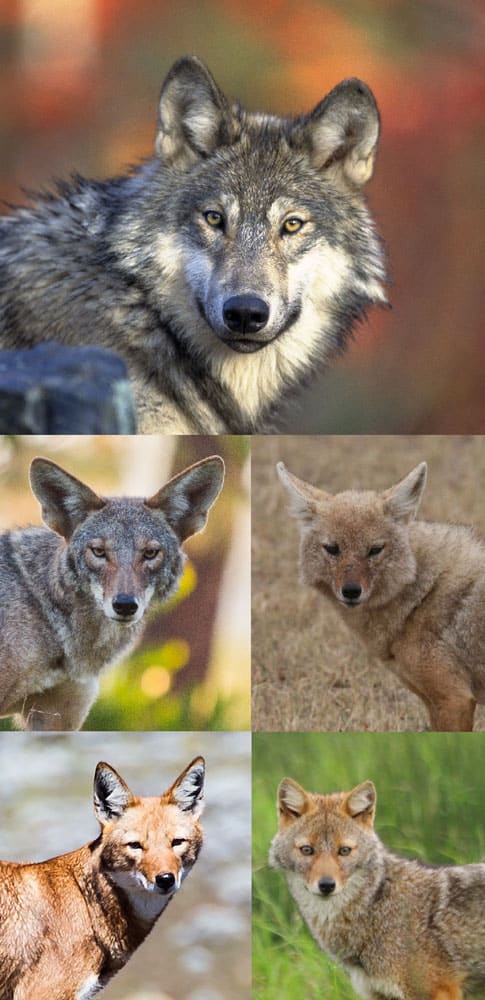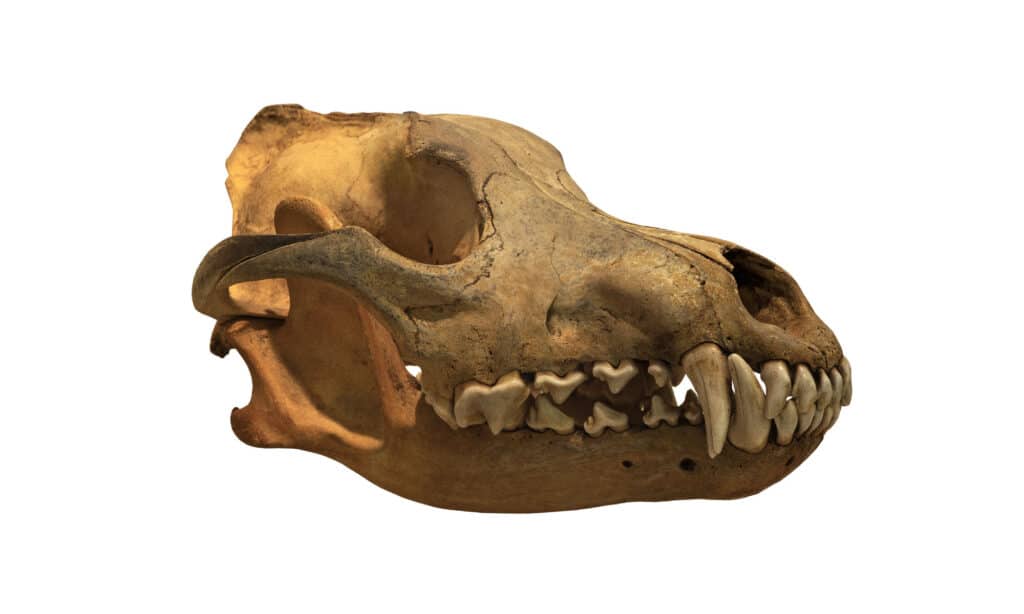Most people know that man’s best friend, the domestic dog, is a descendant of wolves that were slowly domesticated by humans over 15,000 years ago. However, their ancestors were ancient, stretching back millions of years. We know this based on the oldest wolf fossils ever found, and that’s what we’re going to talk to explore throughout this article.
By the time we’ve finished, you’ll know about the oldest wolf species, the oldest fossils from wolves, and what we learned from the discoveries! We’ll show you the oldest fossils of both the extinct species of wolf ancestors as well as the oldest extant wolf fossils ever found!
What Is the Oldest Wolf Species?
The oldest true wolf species is Canis priscolatrans, also called Canis edwardii. This creature appeared a little over 3 million years ago and survived until about 300,000 years ago. This was the first creature that was a definitive wolf species. Yet, if we want a better idea of how far back wolves can trace their lineage, we need to look back even further on the timeline.
The oldest wolf ancestor is believed to be Canis lepophagus. This slender, rabbit-eating canid evolved during the early Pliocene. That means the species lived roughly 5.3 million years ago and disappeared less than two million years ago. The most interesting thing about this species is that it’s believed to be a common ancestor of both wolves and coyotes.
Fossils of this species have been found in several places in North America. Specifically, they’ve been found in Texas, New Mexico, Florida, California, and a handful of other states.
When Did Wolves First Appear?

©Gary Kramer National Park Service from USA Profberger at English Wikipedia Prabukumar84 / Public domain – License
The first creatures that were identified as wolves appeared about 3 million years ago. Yet, the species of wolves that we know today only appeared about one million years ago. The pathway from the Canis lepophagus to the Canis lupus, the gray wolf, is rather long and complex.
One proposed model suggests that the Canis lepophagus branched into the Canis priscolatrans along with Canis latrans (the coyote) along with Canis etruscus. The Canis priscolatrans branch of the phylogenetic tree ultimately led to the dire wolf and two poorly understood wolf species.
The same model suggests that Canis etruscus evolved into Canis mosbachensis, the creature that serves as a very direct descendant of the red wolf, grey wolf, and domestic dog.
While this model is accepted by many scientists, others suggest that wolves’ lineage is far more complex. Some claims include that Canis mosbachensis was a contemporary of the Canis lupus rather than an ancestor.
Regardless, it’s widely accepted that the first ancestor of wolves appeared 5.3 million years ago. Then, the first definite wolf showed up 3 million years ago. Finally, modern extant wolf species appeared about one million years ago. Let’s get back to the purpose of the article and discuss some of the oldest wolf fossils ever found.
How Old Was the Oldest Wolf Fossil Ever Found?

©iStock.com/Wlad74
The oldest wolf fossil ever found was between 3 million and 1 million years old. Fossils of the Canis priscolatrans have been found dating back to a period of time called the Late Blancan stage of the Pliocene epoch or the early Irvingtonian, a period that started roughly 1.9 million years ago.
The exact dates for these fossils are not known, but they have been found in several locations throughout the present-day southwestern United States.
However, the oldest grey wolf fossil ever found was about 1 million years old. The Canis lupus tooth was located in Old Crow, Canada. However, some questions about the exact date of this tooth still exist. Specifically, the age of fossils is often ascertained according to the sediment surrounding them.
The first estimates for this area suggested that the fossil was about 1 million years old, but that might not be accurate. So, if the oldest grey wolf fossil was not 1 million years old, the next oldest specimen that has ever been found was located in Cripple Creek Sump in Fairbanks, Alaska. This specimen is about 810,000 years old.
So, two things are clear. Grey wolves as we know them are probably at least a million years old. Also, they have been found in the northwestern portion of North America. Yet, the grey wolf is not just present in this area. Other subspecies’ specimens dating back about 400,000 years ago have been located in France, with slightly younger ones found in Italy.
So, the oldest wolf species has fossils that possibly date back as much as 3 million years. Meanwhile, the wolves of Canis lupus, the most familiar wolf to people today, appeared about 1 million years ago.
What Did the Oldest Wolf Fossil Teach Us?
The oldest wolf fossils are useful in teaching humans about the way that wolves evolved. Although a mostly accepted evolutionary tree exists for the Canis genus, a great deal of confusion lingers concerning the order of evolution. Some of the wolf species may have lived at the same time as others rather than descending from them.
The older wolf fossils are also useful in tracking the spread of wolves throughout the world. Using fossil records, scientists have discovered the way that grey wolves, dire wolves, and even coyotes have spread across the world.
All in all, the oldest wolf fossils found in the world range across millions of years. At least, that’s if you count Canis lepophagus as the first wolf species. Wolves have been found throughout Europe, Asia, Africa, and North America. Although grey wolves were once endangered, they are no longer endangered. It’s believed that they number as many as 300,000 due to conservation efforts on their behalf!
Up Next:
- What’s the Oldest Elephant Fossil Ever Found?
- This Grizzly and Grey Wolf Can’t Figure Out Who Is Alpha In Tense Standoff
- Red Wolf
- Eurasian Wolf
The photo featured at the top of this post is ©
Sources
- Frontiers in Ecology and Evolution, Available here: https://www.frontiersin.org/articles/10.3389/fevo.2016.00134/full
- Journal of Mammalian Evolution, Available here: https://link.springer.com/article/10.1007/s10914-021-09591-4#:~:text=Age%20Geological%20age%20range%20of,North%20American%20Land%20Mammal%20Age.
- Journal of Mammalian Evolution, Available here: https://link.springer.com/article/10.1007/s10914-021-09591-4
- Pleistocene mammals of Europe. London: Weidenfeld and Nicolson. p. 317. (1970) Kurtén, B
- UTEP, Available here: https://www.utep.edu/leb/pleistnm/taxaMamm/Canis.htm
FAQs (Frequently Asked Questions)
What is the oldest wolf species?
The oldest true wolf species is Canis priscolatrans, also called Canis edwardii. This creature appeared a little over 3 million years ago and survived until about 300,000 years ago.
When did wolves first appear?
The first creatures that were identified as wolves appeared about 3 million years ago. Yet, the species of wolves that we know today only appeared about one million years ago. The pathway from the Canis lepophagus to the Canis lupus, the gray wolf, is rather long and complex.
Thank you for reading! Have some feedback for us? Contact the AZ Animals editorial team.






